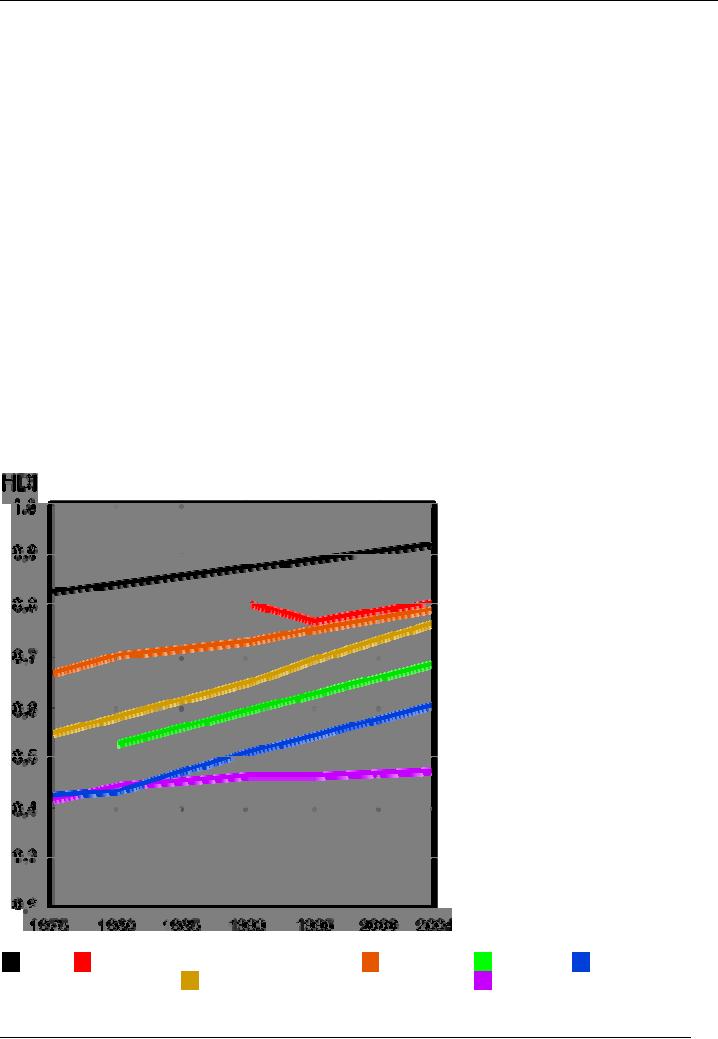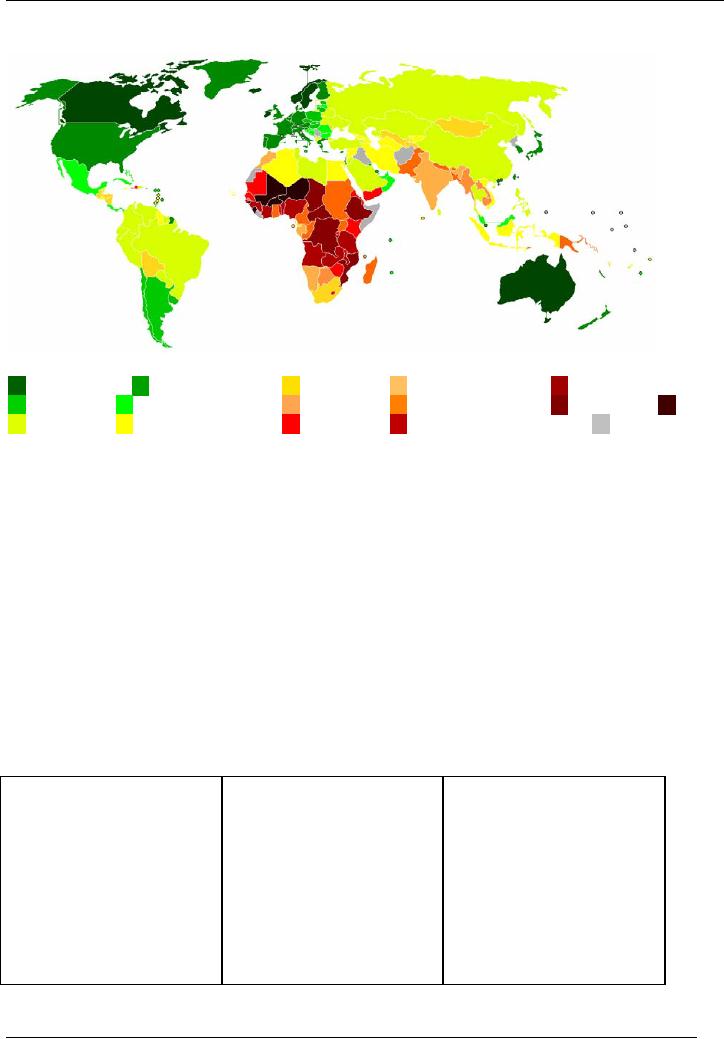 |

Human
Resource Development (HRM-627)
VU
Lesson
21
HUMAN
DEVELOPMENT INDEX
(HDI)
The
Human
Development Index (HDI) is a
comparative measure of life
expectancy, literacy, education,
and
standard
of living for countries
worldwide. It is a standard means of
measuring well being,
especially child
welfare.
It is used to determine and indicate
whether a country is a developed, developing, or
underdeveloped
country
and also to measure the
impact of economic policies on
quality of life. The index
was developed in
1990
by Indian Nobel prize winner
Amartya Sen, Pakistani economist
Mahbub ul Haq, with help
from Gustav
Ranis
of Yale University and Lord
Meghnad Desai of the London
School of Economics and has
been used
since
then by the UNDP in its
annual HDR. Described by Sen
as a "vulgar measure", because of
its limitations,
it
nonetheless focuses attention on
aspects of development more sensible
and useful than the per
capita income
measure
it supplanted, and is a pathway
for serious researchers into
the wide variety of more detailed
measures
contained
in the Human Development
Reports.
The
HDI measures the average achievements in
a country in three basic
dimensions of human development:
·
A
long and healthy life, as
measured by life expectancy at
birth.
·
Knowledge,
as measured by the adult literacy
rate (with two-thirds weight)
and the combined primary,
secondary,
and tertiary gross
enrollment ratio (with
one-third weight).
·
A
decent standard of living, as
measured by the log of gross
domestic product (GDP) per
capita at
purchasing
power parity (PPP) in
USD.
Each
year, UN member styates are
listed and ranked according to
these measures. Those high
on the list often
advertise
it, Former Prime Minister of
Canada), as a means of attracting talented
immigrants (economically,
individual
capital) or discouraging
emigration.
An
alternative measure, focusing on the amount of poverty
in a country, is the Human Poverty
Index
Methodology
HDI
trends between 1975 and
2004
OECD
Central
and Eastern Europe, and the
CIS
Latin
Arab
States
South
Asia
America
and the Caribbean
East
Asia
Sub-Saharan
Africa
In
general to transform a raw variable,
say x, into
a unit-free index between 0
and 1 (which allows
different
indices
to be added together), the following
formula is used:
64

Human
Resource Development (HRM-627)
VU
x
min (x)
·
x-index
=
max
(x)
min (x)
where
max(x)and
min(x)are
the lowest and highest
values the variable x
can
attain, respectively.
The
Human Development Index
(HDI) then represents the
average of the following three
general indices:
LE
25
Life
Expectancy Index =
85
25
2
1
+
Education
Index =
ALI
GEI
3
3
ALR
0
Adult
Literacy Index (ALI) =
100
0
CGER
0
Gross
Enrollment Index (GEI)
=
100
0
log
(GDPpc)
log (100)
GDP
Index =
log
(40000) log
(100)
LE:
Life expectancy at
birth
ALR:
Adult literacy rate (ages 15
and older)
CGER:
Combined gross enrolment ratio
for primary, secondary and
tertiary schools
GDPpc:
GDP per capita at PPP in
USD
UNDP
has created a technical note
on the definition of the HDI.
Examples
Calculation
examples of the
indices.
Minimum
Maximum
Index
Measure
Formula
value
value
L=
LE
25
Longevity
Life
expectancy at birth
(LE)
25
yrs
85
yrs
60
Literacy
rate (LR)
0%
100%
2LR
+ CGER
E=
Education
Combined
gross enrolment ratio
3
0%
100%
(CGER)
Log10 GDPpc
2
40,000
USD G =
GDP
GDP
per capita (PPP)
100
USD
2.60206
65

Human
Resource Development (HRM-627)
VU
2006
report
Main
article: List of countries by
HDI
Coloured
world map indicating Human
Development Index
(2004)
0.950
and over
0.9000.949
0.6500.699
0.6000.649
0.3500.399
0.8500.899
0.8000.849
0.5500.599
0.5000.549
0.3000.349
under
0.7500.799
0.7000.749
0.4500.499
0.4000.449
0.300
N/A
The
report for 2006 was
launched in Cape Town, South
Africa, on November 9, 2006.
Its focus was on
"power,
poverty and the global water
crisis.. Most of the data
used for the report are
derived largely from
2004
or
earlier, thus indicating an HDI for
2004. Not all UN member
states choose to or are able
to provide the
necessary
statistics.
The
report showed a stagnation in
world HDI, as the continued improvement
of developed countries was
offset
by a general decline of the developing
world. Countries in Sub-Saharan Africa
and South Asia showed
an
important
decline in HDI, in comparison with
last year's report. Other
developing regions showed
little to no
improvement.
A
HDI below 0.5 is considered to
represent low
development and 29
of the 31 countries in that category
are
located
in Africa, with the exceptions of
Haiti and Yemen. The bottom
ten countries are all in
Africa. The
highest-scoring
Sub-Saharan countries, Equatorial
Guinea and South Africa,
are ranked 120th and
121st,
respectively
(with a shared HDI of
0.653).
A
HDI of 0.8 or more is considered to
represent high
development. This
includes all developed countries,
such as
those
in North America, Western
Europe, Oceania, and Eastern
Asia, as well as some
developing countries in
Eastern
Europe, Central and South
America, Southeast Asia, the
Caribbean, and the oil-rich
Arabian Peninsula.
Top
thirty countries (HDI range
from 0.965 down to
0.885)
1.
Iceland 0.968
11.
Finland 0.952
21.
Hong Kong 0.937
2.
Norway 0.968
12.
United States 0.951
22.
Germany 0.935
3.
Australia 0.962
13.
Spain 0.949
23.
Israel 0.932
4.
Canada 0.961
14.
Denmark 0.949
24.
Greece 0.926
5.
Ireland 0.959
15.
Austria 0.948
25.
Singapore 0.922
6.
Sweden 0.956
16.
United Kingdom 0.946
26.
South Korea 0.921
7.
Switzerland 0.955
17.
Belgium 0.946
27.
Slovenia 0.917
8.
Japan 0.953
18.
Luxembourg 0.944
28.
Cyprus 0.903
9.
Netherlands 0.953
19.
New Zealand 0.943
29.
Portugal 0.897
10.
France 0.952
20.
Italy 0.941
30.
Brunei 0.894
66

Human
Resource Development (HRM-627)
VU
Top/bottom
three countries by region
Asia
Africa
007.
Japan 0.949
047.
Seychelles 0.842
022.
Hong Kong 0.927
063.
Mauritius 0.800
023.
Israel 0.927
064.
Libya 0.798
138.
Nepal
175.
Mali 0.338
176.
Sierra Leone 0.335
177.
Niger 0.311
67
Table of Contents:
- INTRODUCTION TO HUMAN RESOURCE DEVELOPMENT:The Concept and its Dimensions, Targets of Development
- FOUNDATIONS OF HUMAN BEHAVIOR:Attitudes, Personality, Emotional Intelligence
- PERCEPTION:Attribution Theory, Shortcuts Frequently Used in Judging Others
- INTRINSIC MOTIVATION:Why Choose Big Five Framework?, THE OUTCOME OF FIVE FACTOR MODEL
- FIVE FACTOR MODEL:The Basis of Intrinsically Motivated Behavior, Intrinsic Motivation and Values
- MOTIVATION:EARLY THEORIES OF MOTIVATION, Designing Motivating Jobs
- The Motivation Process:HOW TO MOTIVATE A DIVERSE WORKFORCE?,
- INTERPERSONAL COMMUNICATION:PRINCIPLES OF INTERPERSONAL COMMUNICATION
- THE WORLD BEYOND WORDS:DIFFERENCES BETWEEN VERBAL AND NONVERBAL COMMUNICATION, MINDFUL LISTENING
- TRANSACTIONAL ANALYSIS:EGO STATES, Parent Ego State, Child Ego State
- TYPES OF TRANSACTIONS:Complementary Transactions, Crossed Transactions, Ulterior Transactions
- NEURO-LINGUISTIC-PROGRAMMING
- CREATE YOUR OWN BLUEPRINT
- LEADERSHIP:ORGANIZATIONAL DEMOCRACY
- LEADERSHIP:Environment and Strategic Leadership Link, Concluding Remarks
- UNDERSTANDING GROUP BEHAVIOR:Stages of Group Development, Advantages of Group Decision Making
- UNDERSTANDING TEAM BEHAVIOR:TYPES OF TEAMS, Characteristics of Effective Teams,
- EMOTIONAL FACET:PHYSICAL FACET
- HUMAN RESOURCE DEVELOPMENT & THE ROLE OF GOVERNACE:Rule of Law, Transparency,
- HUMAN RESOURCE DEVELOPMENT:The Concept and Its Dimensions, Targets of Development
- HUMAN DEVELOPMENT INDEX (HDI):Methodology,
- REPORTS:Criticisms of Freedom House Methodology, GROSS NATIONAL HAPPINESS
- SECTORS OF A SOCIETY: SOME BASIC CONCEPTS:PUBLIC SECTOR, PRIVATE SECTOR
- NON GOVERNMENTAL ORGANIZATIONS (NGOS):Types, Methods, Management, Citizen organization
- HEALTH SECTOR:Health Impact of the Lebanon Crisis, Main Challenges,
- A STUDY ON QUALITY OF PRIMARY EDUCATION BACKGROUND AND RATIONALE
- ADULT EDUCATION:Lifelong learning
- THE PRACTICAL PERSPECTIVE OF ADULT EDUCATION:Problems of Adult Literacy, Strategies for Educating Adults for the Future
- TECHNICAL & VOCATIONAL EDUCATION:VET Internationally, Technical Schools
- ASSESSING THE LINK BETWEEN INTELLECTUAL CAPITAL FORMATION AND PERFORMANCE OF A UNIVERSITY
- SCIENCE & TECHNOLOGY EDUCATION:Social responsibility, Curriculum content
- ENVIRONMENT:Dark Greens and Light Greens, Environmental policy instruments
- HDI AND GENDER SENSITIVITY:Gender Empowerment Measure
- THE PLIGHT OF INDIAN WOMEN:
- ENTREPRENEURSHIP:Characteristics of entrepreneurship, Advantages of Entrepreneurship
- A REVISIT OF MODULE I & II
- HUMAN DEVELOPMENT & ECONOMIC GROWTH (1975 TO 2003):
- PUBLIC PRIVATE PARTNERSHIP:Origins, The Desired Outcomes of PPPs
- PRINCIPLES OF PUBLIC PRIVATE PARTNERSHIP (PPP):Situation in Pakistan,
- DEVOLUTION REFORMS – A NEW SYSTEM OF GOVERNMENT:
- GOOD GOVERNANCE:Participation, Rule of law, Accountability
- MACROECONOMIC PROFILE OF A COUNTRY: EXAMPLE ECONOMY OF PAKISTAN
- COORDINATION IN GOVERNANCE: AN EXAMPLE OF EU, The OMC in Social Inclusion
- MOBILIZING REGIONAL EDUCATIONAL RESOURCES: THE ASEAN UNIVERSITY NETWORK, A CASE STUDY
- GOVERNMENT PRIORITIES AND POLICIES:Role of Government, Socio Cultural Factors in Implementing HRD Programs